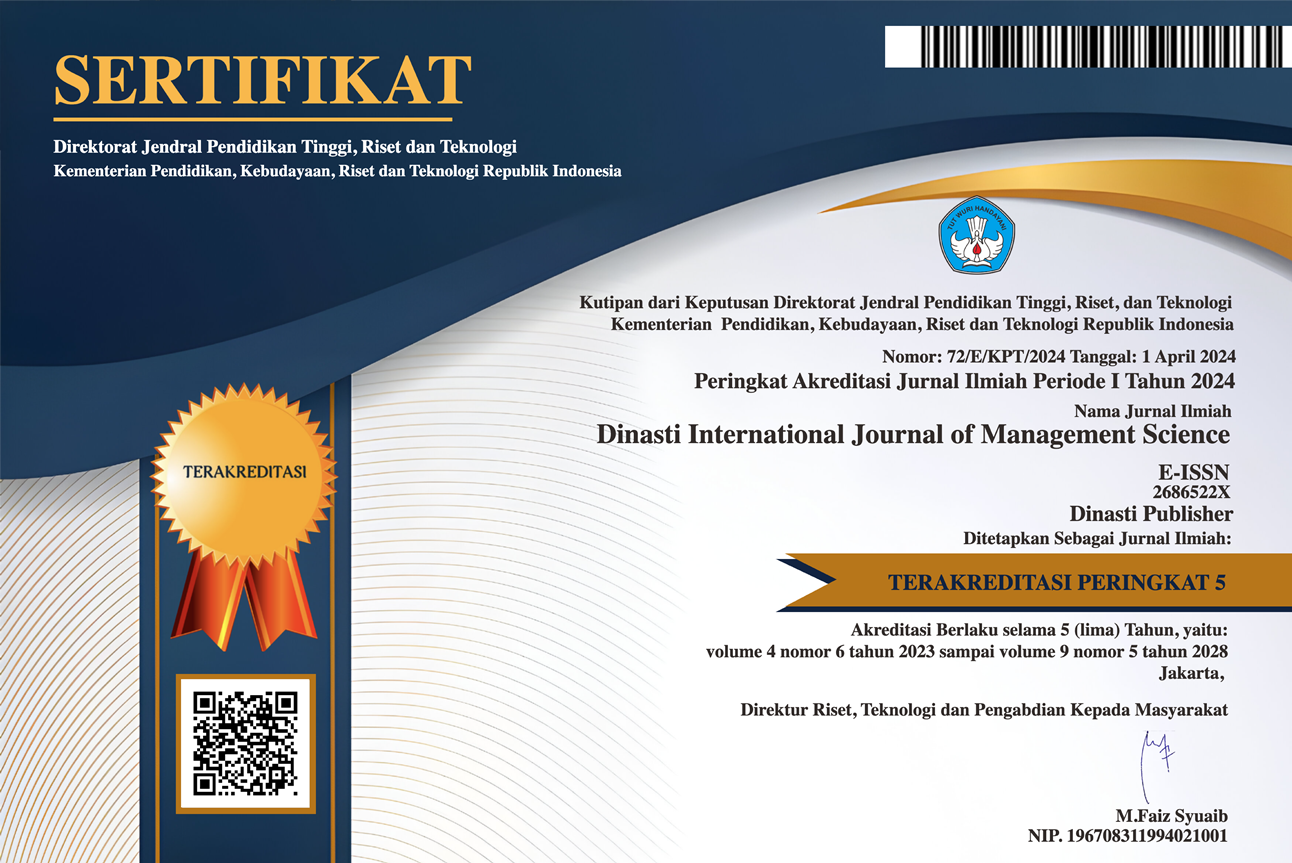A study of Flow and Its Factors Towards Compulsive Buying Based on Player Behavior of Mobile Legends In-Game Items
DOI:
https://doi.org/10.31933/dijms.v5i3.2366Keywords:
Mobile games, Mobile Legends, Enjoyment, Skill, Challenge, Telepresence, Avatar customizationAbstract
Purpose - Examining flow of Mobile Legends player correlating to compulsive buying on in-game items and factors related to flow such as enjoyment, skills, difficulty and avatar identification. Methodology/design - The data were obtained using surveys distributed via several gaming communities' group chats and channels including Discord and WhatsApp, where they were collected from 275 respondents. Findings - The research revealed that flow does have an impact on compulsive buying. Additionally, challenge and telepresence have a favorable impact on flow where skill and fun were not encouraged. Meanwhile, avatar identification is positively impacted by avatar attractiveness and personalization. Avatar identification thus has a favorable impact on flow. This study focused on the connection between compulsive shopping, avatar identity, and player behavior. Originality/value - The research hypotheses for this study can be summed up as: How can flow positively affect compulsive buying? Therefore, this study aims to identify and examine its significance through the variables of player behavior and avatar identification, which are the stimuli of flow in games.
References
Ajzen, I. (1991, December). The theory of planned behavior. Organizational Behavior and Human Decision Processes, 50(2), 179–211. https://doi.org/10.1016/0749-5978(91)90020-t
Al Mawalia, K. (2020). The impact of the Mobile Legend game in creating virtual reality. Indonesian Journal of Social Sciences, 12(2), 49-61.
AppMagic. (August 2, 2023). Most popular MOBA gaming apps worldwide in July 2023, by downloads [Graph]. In Statista. Retrieved August 08, 2023, from https://www-statista-com.upm.remotlog.com/statistics/1269466/most-downloaded-moba-apps-worldwide/
Bae, J., Park, J., Choi, J., Soh, S. B. (2023). A recommending system for mobile games using the dynamic nonparametric model. Journal of Business Research, volume 167.
Faber, Richard J., & O’Guinn, Thomas C. (1989). The Relationship Between Impulsivity and Compulsive Buying. The Journal of Consumer Research.
Gartenberg, Chaim (May 3, 2017). Retrieved August 9, 2023 from https://www.theverge.com/2017/5/2/15517962/china-new-law-dota-league-of-legends-odds-loot-box-random
Ghazali, E. M., Al Halbussi, H., Fattah, F. A. M. A., Uzir, Md U. H., Mutum, D. S., Tan, F. (2021). A study of player behavior and motivation to purchase Dota 2 virtual in game items. Kybernetes, volume 52, no. 6. doi: 10.1108/K-08-2021-0678.
Hoffner, C. and Buchanan, M. (2005). Young adults’ wishful identification with television characters: the role of perceived similarity and character attributes. Media Psychology, volume 7 No. 4, 325-351.
Kim, C., Lee, S.G. and Kang, M. (2012). I became an attractive person in the virtual world: users’ identification with virtual communities and avatars. Computers in Human Behavior, volume 28 No. 5, 1663-1669.
Kim, E., Kim, Y., & Kim, H. (2015). The impact of skill gap on enjoyment in online multiplayer games. Computers in Human Behavior, 49, 85-93.
Kim, K., Schmierbach, M. G., Bellur, S. (Saras), Chung, M.-Y., Fraustino, J. D., Dardis, F., & Ahern, L. (2015). Is it a sense of autonomy, control, or attachment? Exploring the effects of in-game customization on game enjoyment. Computers in Human Behavior, 48, 695–705. doi:10.1016/j.chb.2015.02.011
Liao, G., Cheng, T. C. E., Teng, C. (2018). How do avatar attractiveness and customization impact online gamers’ flow and loyalty?. Internet Research, volume 29, no. 2. doi: 10.1108/IntR-11-2017-0463
Lo, S.K., Lie, T. and Li, C.L. (2016). The relationship between online game playing motivation and selection of online game characters – the case of Taiwan. Behaviour and Information Technology, volume. 35 No. 1, 57-67.
Mason, M. C., Zamporo, G., Marini, A., Ameen, N. (2022). Glued to your phone? Generation Z’s smartphone addiction and online compulsive buying. Computers in Human Behavior, volume 136. Doi: 10.1016/j.chb.2022.107404
Mehrabian, A., & Russell, J. A. (1974). An approach to environmental psychology. The MIT Press.
Ming, J., Jianqiu, Z., Bilal, M., Akram, U. and Fan, M. (2021), How social presence influences impulse buying behavior in live streaming commerce? The role of S-O-R theory. International Journal of Web Information Systems, volume 17 No. 4, 300-320.
Shibuya, A., Teramoto, M., & Shoun, A. (2016). In-Game Purchases and Event Features of Mobile Social Games in Japan. Transnational Contexts of Development History, Sociality, and Society of Play, 95–122. doi:10.1007/978-3-319-43820-7_4
Shimbun, Yomiuri (May 29, 2012). Retrieved August 9, 2023 from https://ameblo.jp/srachai/entry-11265092066.html
Tajfel, H. and Turner, J.C. (1986). The social identity theory of intergroup behavior. In Worchel, S. and Austin, W.G. (Eds), The Psychology of Intergroup Relations, Nelson-Hall, Chicago, IL, 7-24.
Tang, Z. and He, B. (2021). Explaining mobile game takeoff through information configuration. Industrial Management & Data Systems, volume 121 No. 12, 2411-2425.
Teng, C. (2017). Impact of avatar identification on online gamer loyalty: Perspectives of social identity and social capital theories. International Journal of Information Management, Volume 37, Issue 6, Pages 601-610.
Teng, C.I. (2010). Customization, immersion satisfaction, and online gamer loyalty. Computers in Human Behavior, volume 26 No. 6, 1547-1554.
Wang, L., Luo, X., Li, H. (2022). Envy or conformity? An empirical investigation of peer influence on the purchase of non-functional items in mobile free-to-play games. Journal of Business Research, volume 147, 308-324.
Wired (May 12, 2012). Retrieved August 9, 2023 from https://www.wired.com/2012/05/gacha-watch-japan-social-games/
Zenpop (March 23, 2023), retrieved August 9, 2023 from https://zenpop.jp/en/blog/post/5346/the-ultimate-guide-to-gachapon#:~:text=To%20use%20a%20gachapon%20machine,highly%20sought%20after%20by%20collectors.
Downloads
Published
How to Cite
Issue
Section
License
Copyright (c) 2024 Brian Mario Lapasha, Martinus Y Tanuarto, Sujadi Wiranata, RM Bryan Burhamsyah

This work is licensed under a Creative Commons Attribution 4.0 International License.
Authors who publish their manuscripts in this journal agree to the following conditions:
- The copyright on each article belongs to the author(s).
- The author acknowledges that the Dinasti International Journal of Management Science (DIJMS) has the right to be the first to publish with a Creative Commons Attribution 4.0 International license (Attribution 4.0 International (CC BY 4.0).
- Authors can submit articles separately, arrange for the non-exclusive distribution of manuscripts that have been published in this journal into other versions (e.g., sent to the author's institutional repository, publication into books, etc.), by acknowledging that the manuscript has been published for the first time in the Dinasti International Journal of Management Science (DIJMS).
















































